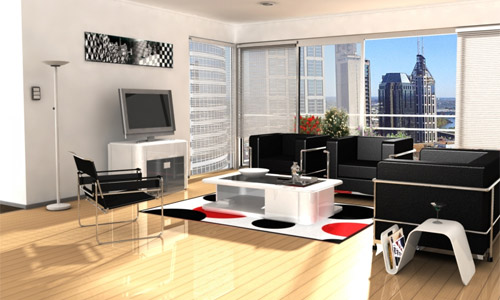In detail: DIY repair of your room from a real master for the site my.housecope.com.
T Anything can be an impetus for repairs. For example, replacing a window block with a plastic one. Further, you will find that everything in the room is interconnected like a garland of monkeys holding each other by the tails.
A new window requires repair of slopes, slopes - replacement of wallpaper. Old skirting boards do not match the new wallpaper. Then it may turn out that the linoleum does not interfere with changing, and the ceiling needs repair after changing the wallpaper. Therefore, it is better to make repairs in the complex, if not a high-quality apartment renovation, then at least a good one room.
However, with the modern abundance of building materials for a decent and inexpensive repair, only desire, a small set of tools and diligence are required. And a little time to finish reading this article.
Economical room renovation
The task of preparation is to turn the room into a "blank sheet" where nothing interferes with further creativity.
First of all, we remove furniture, lamps on the walls and on the ceiling. Instead of a chandelier, we hang a simple cartridge with a powerful lamp.
Moving on to the old finish. We remove all the topcoats that need to be replaced: old wallpaper, old flooring, clean the ceiling from tiles, wallpaper and (or) faded.
At the same time, we clean everything that crumbles and can be cleaned without much effort.
If the coating, like an archaeological site, has many layers, we remove everything, if possible, to putty or plaster.
After clearing the main arrays, we scrupulously remove all kinds of dowels, nails and screws.
We start the repair with rough work, the purpose of which is the repair and preparation of the bases for the application of finishing coatings:
| Video (click to play). |
Good preparation of the base is the key to a quality repair
We cut large cracks, emboss them with plaster putty. With the same compound, we seal potholes, holes from dowels, screws, etc.
We remove the old sockets:
- turn off the electricity supply;
- unscrew the cover, remove or loosen the fastening and spacer screws, take out the socket and disconnect the wires;
- we insulate the ends of the wires, and tuck them into the socket boxes, fixing with tape.
We clean the walls from roughness using a fine plaster mesh. We apply a deep penetration primer. She will solve three problems at once:
- will increase adhesion;
- will strengthen the top layer of structures;
- dedust the surface.
We will start the final finishing from the ceiling, glue it with white expanded polystyrene tiles. This option is economical and easy for the inexperienced repairman. Even without experience, a ceiling of 15-18 m 2 can be pasted over in 6-8 hours.
Unlike painting or wallpaper, tiles do not require high-quality filler or other preparation, but can even be glued to the floor panel.
We use acrylic glue. Unlike transparent polymeric foam adhesives, its adhesion allows you to work according to the principle: "apply, press, forget".
For white tiles, such glue is better, also because it can immediately correct minor flaws like a putty.
The simplest solution for finishing flooring is linoleum. It only requires a tape measure, a marker, a ruler and an edging knife to fit and fit. We buy linoleum according to the width of the room and lay it with a solid carpet, without gluing it.
We roll out the roll and let the material sit for a couple of days to get rid of irregularities. Then we cut to size following a simple rule: not sure - do not cut.
If you are still in doubt, cut off deliberately less than necessary. Linoleum is easy to cut, but fixing if you cut off the excess is not an easy task.
We cut it with an ordinary stationery knife.A wide spatula is suitable as a ruler, and in its absence, a building level.
Pasting the walls with wallpaper completes the main renovation work. We take paper wallpapers, as they are the most inexpensive.
Before starting work, you need to make sure that the planes of the floor and ceiling are parallel to each other. Or their horizontal difference does not exceed 5-7 mm. In this case, you can cut five or six strips from wallpaper rolls at once. We leave one to adjust the pattern of the following canvases, grease and glue the rest.
If the difference in the distance from floor to ceiling in different corners exceeds a centimeter, you should not cut more than two strips. You can make a mistake, and it turns out that, for example, at the top the sheet is wrapped on the ceiling, and at the bottom it does not reach the plinth.
After smearing the strip with glue, fold it up. First, we transfer the edges to the middle, then in half, and again in half (see Fig. 1). We put it in a pack. After the last sheet has been processed, we turn the pack over so that the first of the greased sheets is on top, and we begin to glue.
We start pasting from any corner of the room, preferably from the one closest to the window.
After gluing the prepared canvases, we cut new ones and repeat all over again.
We do not regret the glue for the preliminary priming of the wall. With special care we coat its upper quarter, and the places where the joints are supposed to be.
Installation of floor skirting boards is the only operation that requires a hammer drill with a 6 mm diameter drill.
It is better to start the installation of plastic skirting boards from the same corner from where you started to glue the wallpaper.
For fastening we use nails "quick installation" 3-4 cm long. We put them back 10-12 cm from the edge of the plinth strip and then approximately every forty centimeters.
Glue the ceiling skirting boards made of polystyrene directly over the wallpaper. We use the same white acrylic glue. Accurate cutting in corners is difficult for a beginner, even under a miter box, but using glue as a putty can eliminate most of the blemishes.
We complete the repair by installing sockets, replacing the switch, returning the chandelier and lamps to their place.
The renovation is complete. It remains to dust off and celebrate its end.
Ask questions in the comments below or by mail. Subscribe to the newsletter. Good luck to you, and good to your family!
After reading this article, you will learn how to renovate a room with your own hands, how to come up with a design, choose finishing materials and, step by step, complete all the work.
The houses, designed 20 years ago, have balconies that tightly block the windows. Thus, sunlight cannot enter the room at all.
The atmosphere of home comfort, according to an old Soviet habit, is created by lining up brown cabinets on one side, and the opposite wall is usually occupied by a row of seats (a sofa and a pair of monster armchairs).
The view of the cabinets from this angle is indeed the most panoramic. Thus, the missing feeling of a narrow corridor is given to the room. Carpets on the walls with psychedelic patterns complement the cozy interior of a typical room in a typical apartment. Sound familiar?
When deciding what repairs to make in the room, first of all get rid of the trash, as well as the design ideas of a past era. Bright rooms, cheerful colors, functional furniture and large spaces are in vogue today.
Decide which room to start the renovation from. According to all the rules, major repairs in an apartment begin from its farthest corner.
Last but not least, the hallway is being repaired. Why? Because the corridor is the most passable place in the apartment. Therefore, construction debris, dust and dirt will appear here one way or another. Not so offensive if they cover up the old trim that you intended to remove anyway.But if the debris settles on the brand new recently finished walls in the hallway, you quickly realize your mistake.
Having decided on the place of repair, decide how the outcome of your work should look like. Do you want to make only cosmetic repairs or are you dreaming of global interior changes?
On a sheet of paper or in a specialized computer program, create a sketch of the future room. Once the “project” has been approved with the family and aligned with the budget, write down the step-by-step steps to achieve your goals.
Note! Even if you are very economical in spending money on repairs, at the stage of drawing up a design project, it would still not hurt to use the help of professional designers. They will help not only to competently change the interior, increase the space, but also to choose finishing materials that will perfectly fit into your budget.
The sequence of repairing a room, like any other room, as a rule, does not differ in variety.
- Repair begins with the removal of old coatings from the walls and ceiling. If you plan to remodel the flooring, the demolition work will also touch the floor..
- Preparation for dismantling consists in taking out all the furniture. If this is not possible, it is better to cover all surfaces.
- At this stage, the wallpaper is removed, paint and plaster are removed from the walls and ceiling. Further actions will depend on what kind of decoration of the apartment with your own hands you are going to do.
- If the walls are planned to be pasted over with thick wallpaper, upholstered with wall panels, and the ceiling is closed with a tension or curtain structure, you can not waste time on leveling the surfaces. The listed finishing materials will perfectly hide all the flaws.
- If the repair consists in pasting with thin paper wallpaper, applying a layer of decorative plaster on the walls, a flat surface will be necessary. An excellent result is achieved by applying a primer to the walls and ceiling and 2-3 layers of putty.
Note! Allow the putty to dry for 24 hours before applying each new coat.
- If the repair involves the installation of electrics, reinstallation of heating pipes, installation of an air conditioner, stretch and suspended ceilings, these works are performed before the start of finishing the premises.
The last stage is wallpapering the walls, installing wall panels, applying decorative plaster. Of all the above, the most affordable price is inherent in wallpaper.
When choosing materials, it is worth considering the type of room in which the renovation is being carried out. For example, inexpensive paper wallpaper or decorative plaster, which is resistant to mechanical damage, is suitable for decorating a nursery.
When renovating the hall, purchase more expensive materials, because the living room is the face of the house. Bathroom decoration presupposes the presence of heat and moisture resistant materials - tiles, film stretch ceilings.
For the renovation of a room, 16 sq. m can take 6 rolls of wallpaper and 6 packs of wallpaper glue. It is worth considering these numbers when purchasing materials from a store.
Thus, repairing a room is, albeit a tedious, but solvable task, which (if you put the whole family on it) can be solved in the shortest possible time. Of course, it all depends on the size of the room that you are going to renovate.
We hope you found our article helpful. In order to more accurately understand the technological and practical issue, our website contains detailed photo and video instructions, in which you will find useful information on this issue.
Where to start repairing an apartment so that the repair work does not stretch out for an indefinite period, and the end result undoubtedly pleases you, this is what will be discussed in today's article. Renovation of the apartment requires serious preliminary preparation. The most important point is drawing up a detailed plan for future repairs, taking into account the smallest nuances.Consider, point by point, the advice of professionals on the correct organization of repair work in houses and apartments.
First of all, you need to decide on the complexity and volume of future repairs. To make the apartment bright and clean, sometimes it is enough to carry out cosmetic, superficial repairs: replacing the wallpaper, whitewashing the ceiling, changing the old linoleum, painting the walls, etc.
If you want to completely get rid of everything that is boring and old, decide on a major overhaul with the replacement of windows, leveling the walls, installing new floors, modern ceilings. Your home will be transformed and become new and beautiful.
You should not refuse the help of experienced specialists when carrying out major repairs. This is especially true for the creation of a modern design for your apartment, including redevelopment and the demolition of some walls and partitions.
Plan renovations based on your financial capabilities.
First, decide on the interior and design of each individual room that you plan to change in your apartment. You can seek advice from a professional designer, which will slightly increase your total financial expenses for repairs. For rooms where renovation will be carried out, it is necessary to complete detailed drawings of the successive stages of repair work.
We recommend that you complete five detailed renovation sketches for each individual room. In the first drawing, display the top view of the room, and in the other four, each wall. Complete each drawing with a detailed description and a plan for the sequential implementation of repair work, which will avoid omissions and inaccuracies in the work.
When drawing up a repair sketch, it is recommended to indicate:
- Think over the location of the furniture. Those walls that will be most conspicuous need to be given special attention and use the highest quality finishes.
- Think about where it would be best to place lamps and chandeliers so that the light illuminates the room as much as possible.
- Given the location of the household appliances, indicate the locations for the outlets. To then correctly design the installation of electrical wiring in all rooms.
- Consider the location of the main decorative elements: paintings, mosaics, brick walls.
In the repair plan, you need to indicate the desired finishing option: wallpapering the walls, painting, etc. To divide a room into separate zones, designers recommend painting one of the walls in a different color in order to focus on it and visually divide the room. These moments also need to be reflected in the plan.
According to the advice of experienced specialists, in order to avoid unnecessary dirt and dust during repair work, it is recommended to first of all carry out repairs in the rooms farthest from the front door. The final stage of the repair, it is advisable to choose passage rooms and a corridor through which building materials and tools are constantly sweeping. This is necessary in order not to stain or scratch the finish of the already repaired wall, not to damage the new floor.
An additional protection of the repaired room can be a cellophane film (fixed on the outside of the door), which will reliably protect the room from construction dirt, dust, plaster, paint, and accidental damage.
Do not carry out all repairs yourself. At your request, the execution of all repair work or only the performance of particularly complex repair operations can be entrusted to qualified specialists. Firstly, experience and knowledge will allow them to carry out repair work quickly and efficiently. Secondly, you do not have to additionally buy expensive tools, with the help of which the screed is ideally poured onto the floor or the tiles are laid out.
Even if the installation of an interior door seems easy to you, the slightest inaccuracy is unacceptable here.Of course, you can hang and arrange kitchen furniture, level the walls and paint a little yourself. But entrust more complex repair work to specialists so that you do not have to redo it, which can significantly increase your financial costs for repairs.
#one. After the final choice of the design of the appearance of the rooms, furniture and interior, it is necessary to draw up a complete list of the necessary building materials. Their number and total cost depends on the amount of repair work and how they are carried out. If the budget allows you, you need to purchase building materials with a small supply.
# 2. Make a separate list of decor items: holders, shelves, mirrors, paintings, etc. Start your purchases with the selected decor elements. If the planned decor element is not available, you can quickly change or create a new design version of the apartment renovation.
# 3. Make a list of the building tools you need to complete the renovation. To do this, you can use the advice of a sales assistant in hardware stores or qualified repairmen.
When the preparatory work has been carried out: plans and sketches of the repair have been drawn up, lists of the necessary materials and tools have been prepared, a decision has been made about the possibility of self-repair or with the help of repair specialists, you will be able to calculate the approximate total cost of the planned repair.
You should not rush to purchase all the materials when you visit your first store. In the compiled lists of materials and tools, put down the prices of different stores, which will allow you to make purchases at a minimum cost. Carefully consider the choice of repair crew services. Pay special attention not only to the proposed cost of repair work, but also to the feedback from your friends about the quality of repair services.
To protect furniture from damage, construction dirt and dust, collect it in a central area of the room. Then carefully cover with plastic wrap. This will free up access to the walls and ceiling. Move expensive equipment and clothes to other rooms.
Repair work should start with the most dusty ones: replacing window blocks, window slopes and installing new window sills. This will avoid dirt and dust during painting work, when it is forbidden to open windows in order to avoid temperature extremes and an increase in humidity. When windows, slopes and window sills are installed, cover them with plastic wrap or hardboard to avoid accidental mechanical damage and contamination.
Mark the installation locations of additional outlets, make the electrical wiring. Do not install sockets or plug them into the enclosure at this point.
In the case of welding work (for example, when replacing heating radiators), do them at the same time in different places of the apartment in order to quickly complete this dusty and difficult stage of work, sometimes including breaking down walls.
Before repairing walls, floors, ceilings, you must check their condition with a laser or water level. Begin by applying the thickest layers of mortar. As they dry out, you can carry out other minor repairs without downtime.
After completing this preparatory stage, proceed with the repair work, performing them in the following sequence: repair of the ceiling, walls, floor. Initially, work is carried out using putty, cement, gypsum mixtures. Then they begin to work on the installation of the floor, doors, slopes.
Final repairs:
- Pasting or painting the ceiling.
- Wallpapering or painting the walls.
- Installation of flooring.
- Installation of skirting boards, sills, platbands.
















